From general-purpose to high-end measurements, multimeters are widely-used tools. Today, there is an extensive variety of multimeters in the market, including ones with wireless capabilities and touch-screen interfaces to make measurements intuitive. In this article, we attempt to guide you in selecting the right multimeter for your needs.
Also known as multitesters or volt-ohm meters, multimeters are offered by various test and measurement (T&M) companies in diverse form factors, from benchtop to handheld and clamped. These fit a large array of applications, such as industrial, educational or general-purpose measurement, to name a few.
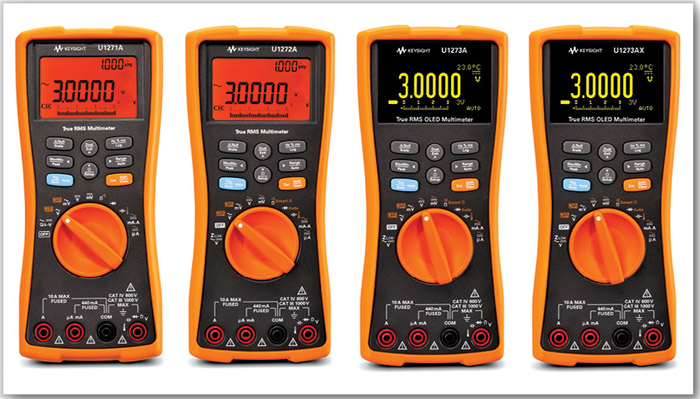
Whether you are looking to buy a new multimeter or a used one, it is important to understand the capabilities as well as performance of the device. Accuracy is an essential factor that could determine the choice of the multimeter you plan to settle for. Depending on your usage and application, there is a plethora of multimeters available in the market. Let us dive into how T&M vendors are improving these devices feature-wise, which will be followed by some important parameters that need to be considered before buying a multimeter. Along the way, we also highlight some of the latest entrants in multimeters.
Trends in today’s multimeters—data logging and wireless connectivity
Increasingly, digital multimeters need to offer more multifunction capabilities to suit a wider scope of applications in today’s demanding measurement environments. Yet, the multimeter preferably needs to be more compact and lighter than before, and be able to deliver higher accuracy across a larger number of measurements, while continuing to offer safety, warranty and support, informs Ravi Pagar, regional director, element14. He says, “In recent years, data sharing is a key requirement, where users need to share a large amount of data quickly and accurately.” Latest improvements in digital multimeters, which include addition of more useful functions, connectivity and higher safety levels, are making these more versatile.
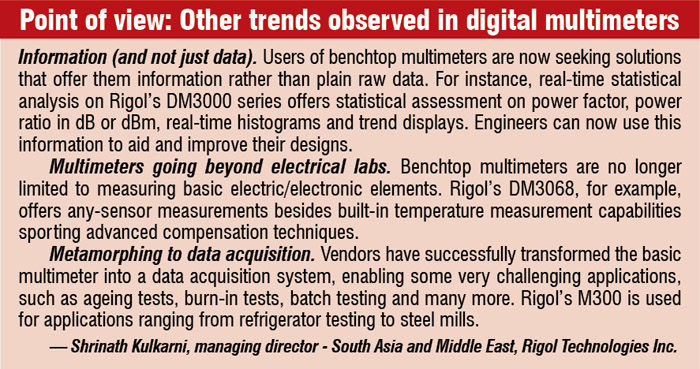
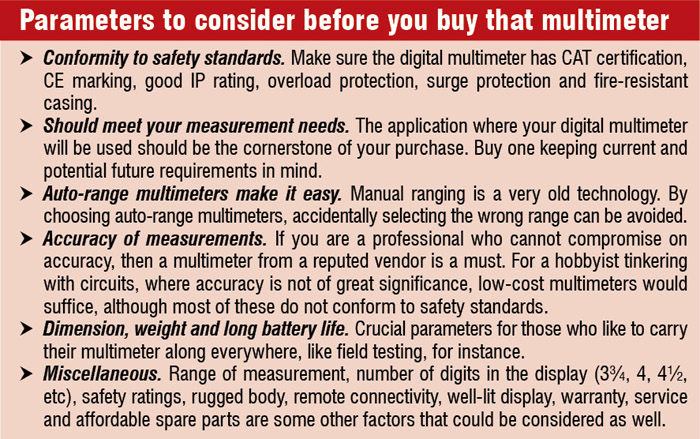
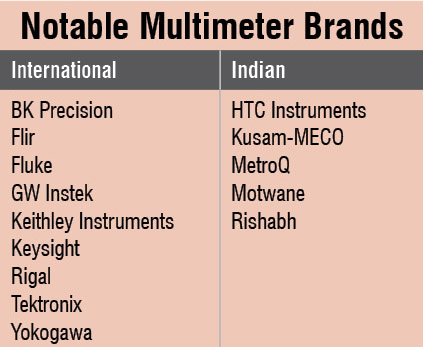 Multimeters these days are sturdier and electrically safe for the person handling these, informs Kritikesh Kumar, national sales and marketing head – test and measurement business division, Yokogawa India Ltd. He says, “Apart from the ruggedness, digital multimeters churn out a much better level of accuracy and resolution. Users can now be more sure about the readings obtained in their instruments.” He adds, “Multimeters also come with data logging and PC connectivity. This cuts down the task of manually writing down data or finding a place to store it.”
Multimeters these days are sturdier and electrically safe for the person handling these, informs Kritikesh Kumar, national sales and marketing head – test and measurement business division, Yokogawa India Ltd. He says, “Apart from the ruggedness, digital multimeters churn out a much better level of accuracy and resolution. Users can now be more sure about the readings obtained in their instruments.” He adds, “Multimeters also come with data logging and PC connectivity. This cuts down the task of manually writing down data or finding a place to store it.”
Nowadays, wireless connectivity is also increasingly being incorporated into multimeters. Industry experts feel that connectivity today is slowly becoming a part of multimeters. Manish Kwatra, CEO, MetroQ, says, “Apart from universal serial buses (USBs), manufacturers are coming up with Wi-Fi-enabled multimeters. A year or two down the line, connectivity in multimeters will become standard.”
Rajesh Sawant, business development manager, Keysight Technologies India Pvt Ltd, too feels that connectivity is an important feature for multimeters. Talking about how it benefits users, he says, “Communication of various instruments on a common platform via wireless connectivity enables remote operations, monitoring and logging of parameters, thereby enhancing the productivity of the user.
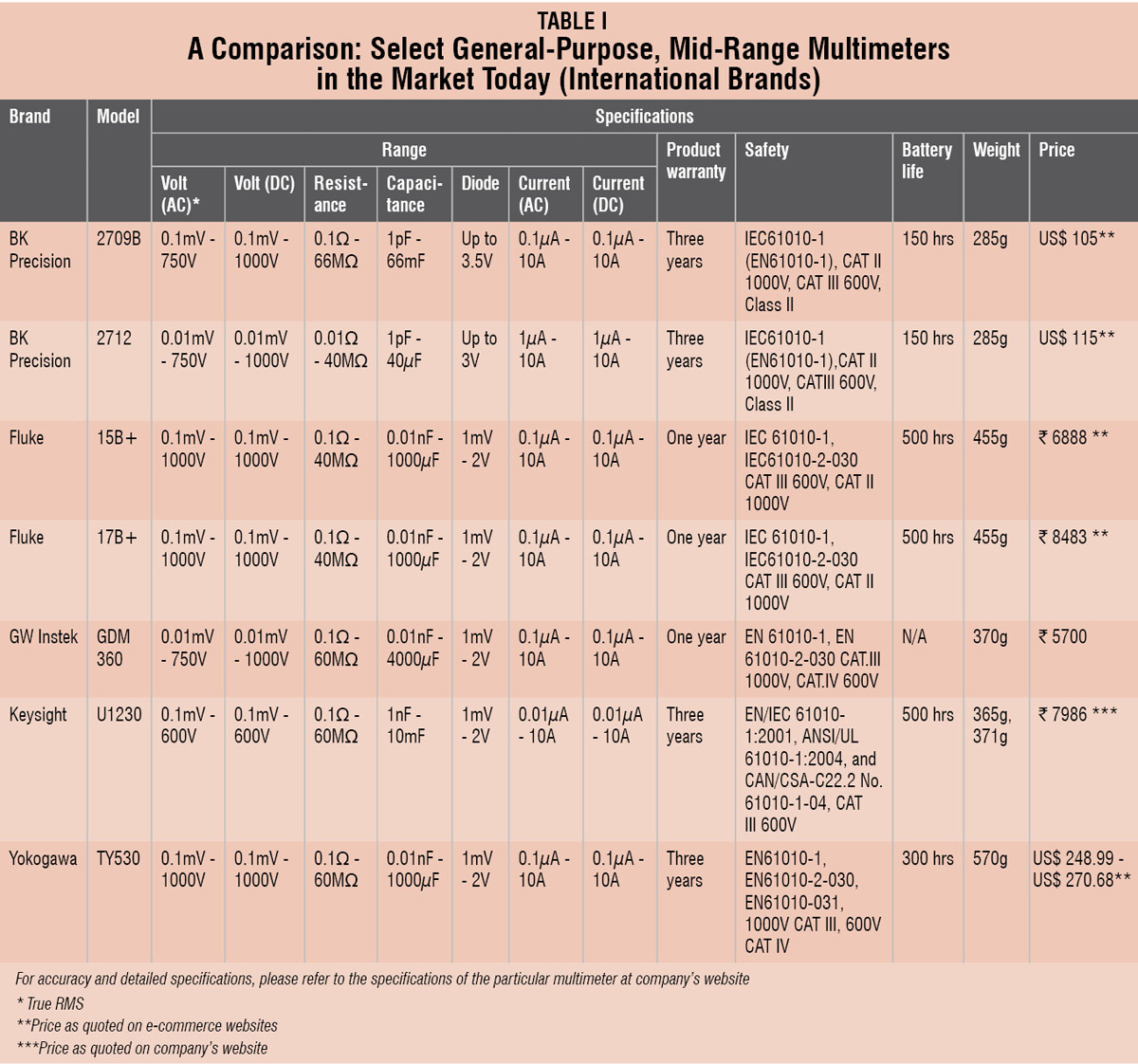

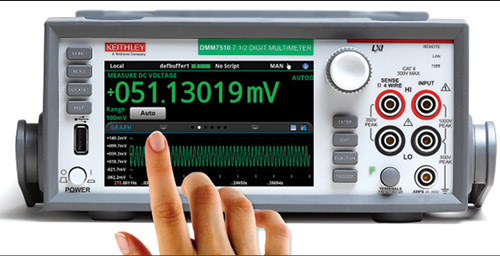
A multimeter normally does not show a waveform. Therefore in some multimeters, an oscilloscope is in-built for waveform analysis, informs Kwatra. He says, “These scopemeters (multimeters + oscilloscopes) generally offer 20MHz to 25MHz bandwidth.” Today’s multimeters use advanced microcontrollers or application-specific integrated circuits (ASICs) to be able to support more functions accurately, notes Chandmal Goliya, director, KUSAM-MECO.
What is new in multimeters, feature-wise
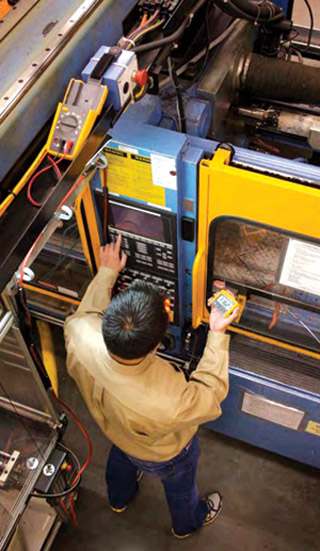
Wireless connectivity and data logging. Some T&M companies have launched next-generation wireless connectivity solutions for digital multimeters that let you measure over a greater expanse, quicker and trouble-free. For instance, Fluke’s CNX 3000 wireless multimeter allows you to access live measurements from three wireless modules, apart from the meter reading, from up to 20 metres away. This helps in seeing cause and effect in a chain of events, interactions between inputs/outputs or other measurement points, remotely as well as simultaneously.
In the case of Keysight’s U1200 series digital multimeters, a user can add Bluetooth connectivity by attaching U1117A IR-to-Bluetooth adaptor to the IR port, and U1115A remote-logging display can be used to view and log test measurements with an extended range of up to 100 metres. Yokogawa’s TY series of multimeters have data logging capabilities that enable the user with hands-free data storage and provides online graphical plots as well.
Flir’s DM93, too, features wireless functionality connecting to two sets of devices—FLIR thermal cameras and mobile platforms—all via Bluetooth. Sam Ruback, product manager – test and measurement, FLIR, says, “Connecting to your iOS, Android and even your PC with FLIR software tools adds convenience and safety for your problematic testing targets.” He adds, “We have an exclusive Meterlink technology that integrates DM93’s digital multimeter measurement data onto FLIR Meterlink-enabled cameras for advanced analysis.”
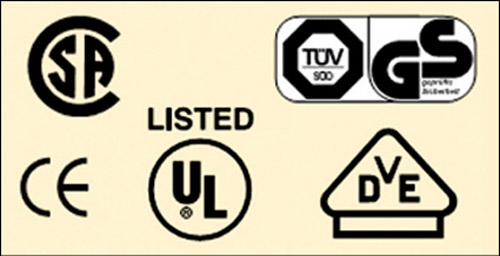
Touch-screen interface. Slowly, vendors are starting to incorporate a touch-screen user interface to their T&M equipment. Be it oscilloscopes or digital multimeters, touch-screen is slowly trickling down to T&M tools with the aim of making these more intuitive, interesting and easy to learn for users. Claimed to be the first in a new class of digital multimeters, DMM7510 from Keithley Instruments is an integration of 1MS/sec, 18-bit digitiser for waveform capture, 12.7cm (5-inch) capacitive touch-screen display and, of course, a digital multimeter with resolution levels ranging from 3½ to 7½ digits.
The touch interface allows you to set up test faster and view results numerically as well as graphically on the screen with the ability to pan, pinch and zoom the waveform or signals, making high interaction with the data possible.
In a release, Jerry Janesch, senior market development manager at Keithley, noted that their DMM 7510 aids engineers to capture small signals at greater accuracy and pace in comparison to traditional digital multimeters currently in the market. Engineers get an in-depth understanding of their devices under test. To enhance low-level accuracy, this multimeter has expanded measurement ranges (100mV, 1Ω and 10µA). DMM7510 looks to address a wide range of test applications, including device characterisation, debugging and analysis, production or automated test, and applications in universities and research and development labs.
Detachable display. This feature enables an engineer to take a clamp-on reading, be it voltage, current, resistance or capacitance, by making use of wireless technology and display of the multimeter, which is detachable. The user can record data from up to 9.1m (30-feet) away from the location of the test probes and meter body. This feature can be seen in Fluke’s 233 wireless digital multimeter.
Make the right choice
Following parameters could help you in locking down the multimeter perfect for your usage.
Safety comes first. A digital multimeter has the capability to identify a problem in a circuit, but it is important to know its limitations else it could result in equipment damage and possibly cause personal injury. Before buying one, you must ensure that it is designed to pass international standards of electrical safety, such as CAT (a safety standard for electrical installations and equipment). For single-phase industrial use and three-phase distribution, CAT-III is necessary. IEC 1010 standard (International Electro-Technical Commission) is another standard for low-voltage T&M equipment. Also, make sure your multimeter has a CE marking (a certification which means, the product meets European standards).
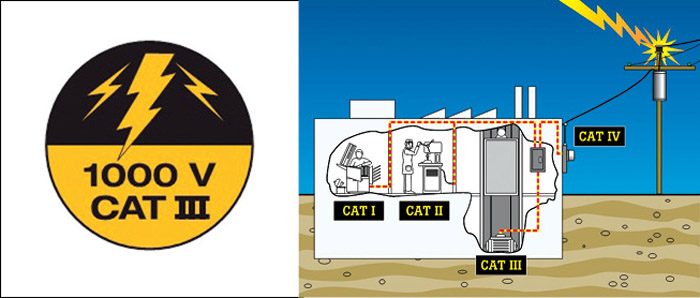
Goliya says, “The user must look for safety features, such as overload protection in various ranges, safety categories like CAT IV 600 V or CAT III 1000V, surge protection (8kV-12kV) as well as electromagnetic compatibility (EMC) protection.” He adds, “Shielding from strong magnetic fields to give accurate readings even in strong magnetic field areas and fire-resistant casings for operator safety are also very important in a multimeter. The tendency of most purchasers is to buy the cheapest multimeter, thereby compromising on safety.”
Kumar informs that for any 600V digital multimeter, there has to be a CAT III protection level, and every 1000V multimeter should have a CAT IV protection level.
Use areas. It comes down to one question: What would you mostly be using the digital multimeter for? The major factor to choose a multimeter should be driven by your application. “It is a crucial parameter to consider. Some people go for a multi-range multimeter even though they might not require one. If a user needs a little bit of everything, then he or she should go for a general-purpose multimeter,” says Kwatra. If you are a professional electronics design engineer, then you should consider a multimeter from reputed brands that provide measurement convenience, safety and great build quality, even though these might be slightly expensive.

For a hobbyist tinkering with circuits, where accuracy is not of great significance, low-cost multimeters would suffice, although most of these do not adhere to safety standards. As you transition to high-end multimeters, these become very application-specific. There are a variety of application-specific multimeters available for areas such as industrial, automotive, audio and sound, among others. Therefore it is extremely important for a user to know the purpose and usage areas before buying a multimeter.
Auto-range multimeters. Most of the multimeters available today are auto-range as these are simpler to use and avoid wrong range selection. Manual-range multimeters, which is a pretty old technology, require you to select the range manually each time you make different measurements, which can get tiresome in the long run. An auto-range multimeter with the manual-range override control can be very handy as it provides you with an option of to fix the range manually.
Other specifications. Accuracy of a digital multimeter is a key parameter. Apart from accuracy, some other features to look out for include the range of measurement, number of digits in the display, safety ratings, rugged body, long battery backup, remote connectivity and better IP (international protection or ingress protection) rating. Dimension and weight could be important for engineers who prefer portability with multimeters. “A user, having fixed his or her requirements, should select the instrument not only for present requirements but also future needs,” informs Goliya.
A reasonably large, clear and well-lit display for comfortable readings with availability of warranty, service and affordable spare parts could prove to be beneficial in the long run.
Choose wisely, measure well
Multimeters are one of the most widely used T&M equipment. Although there are a variety of brands and multimeters out there, the area where your digital multimeter will be used remains the cornerstone of your purchase. Low-end multimeters come in handy for DIY electronics. But most of the cheap multimeters do not conform to safety standards, therefore it would be preferable to select one from a known brand.










